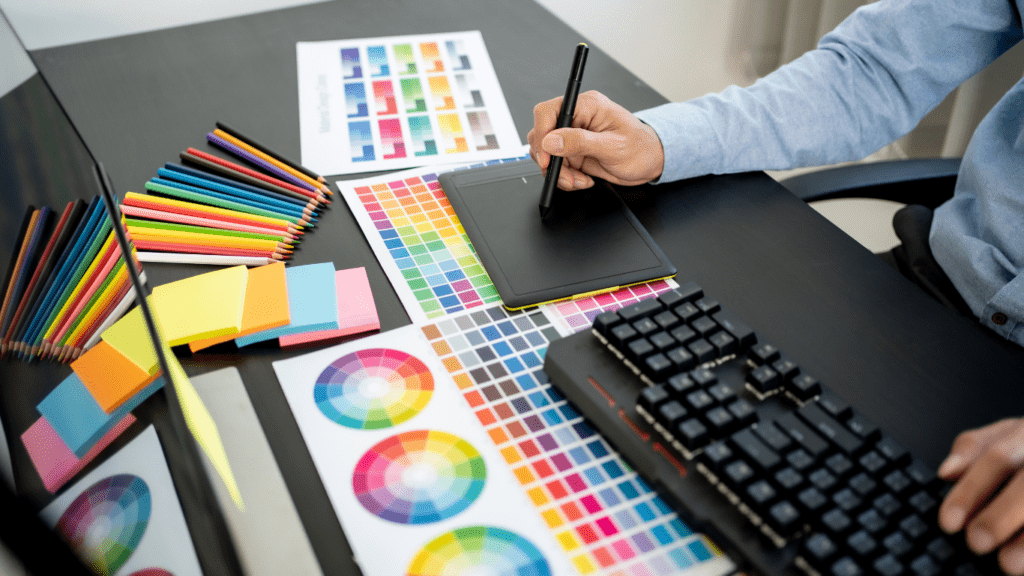Understanding Digital Art
Digital art encompasses creativity and technology, allowing artists to create, edit, and share their work via digital mediums.
What Is Digital Art?
Digital art involves using technology, particularly digital tools, to create artwork. It includes various forms such as digital painting, 3D modeling, and graphic design.
Artists use devices like tablets and software like Photoshop and Illustrator. Unlike traditional art forms, digital art offers endless manipulation possibilities and easy replication.
History and Evolution of Digital Art
Digital art’s roots trace back to the 1950s when scientists and engineers started exploring computer graphics. Early experiments included artists collaborating with technicians to produce digital images.
The 1980s saw significant advancements with the introduction of personal computers and graphic software. By the 1990s, digital art became more mainstream, with artists regularly using software to create work. Contemporary digital art encompasses VR, AR, and interactive installations, reflecting rapid technological advancements.
Tools and Software for Digital Art
Digital art relies on powerful tools and software. These tools allow artists to transform their creative ideas into stunning visuals.
Choosing the Right Software
Selecting software suited to your needs is vital in digital art. Many options cater to different styles and skill levels. Adobe Photoshop is popular for its comprehensive features, ideal for photo manipulation and digital painting.
Adobe Illustrator excels in vector-based art and graphic design, making it perfect for creating logos and illustrations. Corel Painter mimics traditional painting techniques with its realistic brushes.
If you’re starting, Procreate on the iPad offers a user-friendly interface and robust functionality. For 3D modeling, Blender provides an open-source solution with powerful capabilities. Experiment with trial versions to find the best fit for your workflow.
| Software | Use Case | OS Compatibility |
|---|---|---|
| Adobe Photoshop | Photo manipulation, painting | Windows, macOS |
| Adobe Illustrator | Vector design | Windows, macOS |
| Corel Painter | Traditional painting | Windows, macOS |
| Procreate | Sketching, painting | iPad (iOS) |
| Blender | 3D modeling, animation | Windows, macOS, Linux |
Essential Hardware for Digital Artists
Quality hardware enhances the digital art experience. A high-resolution monitor displays fine details accurately. Wacom tablets are industry favorites, providing pressure sensitivity that mimics real brush strokes. For an all-in-one solution, the Apple iPad Pro with the Apple Pencil offers portability with precise control.
Computers with powerful graphics cards handle resource-intensive tasks like 3D rendering efficiently. ASUS and Dell offer reliable machines suitable for digital creation.
Comfortable drawing peripherals, such as an ergonomic mouse and keyboard, prevent strain during long working sessions. Investing in reliable storage solutions like SSDs ensures your projects are safe and accessible.
| Hardware | Key Features |
|---|---|
| Wacom Tablet | Pressure-sensitive pen, varied sizes |
| Apple iPad Pro | Portability, Apple Pencil support |
| High-Res Monitor | Accurate color representation |
| Powerful PC/Laptop | High-end GPU, sufficient RAM |
| SSD Storage | Fast data access, reliability |
By aligning my tools and hardware with my creative needs, I maximize productivity and bring my artistic visions to life efficiently.
Types of Digital Art
Several types of digital art cater to different styles and preferences, allowing artists to explore diverse creative avenues. Here’s a closer look at some notable categories.
2D and 3D Art
2D Art includes illustrations, paintings, and animations created on a flat surface. Programs like Adobe Photoshop and Corel Painter offer extensive tools for creating intricate 2D images. Artists can manipulate layers, add textures, and make adjustments with precision.
3D Art involves creating three-dimensional objects and environments. Software such as Blender and Autodesk Maya helps artists design, model, and render 3D artworks. 3D art is essential in video games, movies, and virtual reality.
It involves complex processes like modeling, texturing, rigging, and animation to create lifelike and surreal visuals.
Pixel Art and Vector Graphics
Pixel Art is a form of digital art where images are edited on the pixel level. It’s reminiscent of early video games. Tools like Aseprite and GraphicsGale are popular among pixel artists. This art form emphasizes precision, with each pixel contributing to the final image.
Vector Graphics use geometrical shapes like points, lines, and curves. Adobe Illustrator and CorelDRAW are key programs for creating vector art. Unlike raster images, vector graphics are scalable without loss of quality. This makes them ideal for logos, icons, and typography.
Creating Your First Digital Artwork

Starting your first digital artwork can be exciting and intimidating. Follow these steps and tips to ease into the process.
Basic Techniques and Tips
Understanding some basic techniques helps lay a solid foundation.
- Choose the Right Software: Programs like Adobe Photoshop, Corel Painter, and Procreate offer beginner-friendly interfaces and robust toolsets.
- Learn Layers: Use layers to separate different elements of your artwork, making it easier to edit and refine.
- Experiment with Brushes: Explore various brush options to understand how they affect texture and style.
- Zoom In and Out: Change your zoom level to manage details and the overall composition efficiently.
- Utilize Shortcuts: Master keyboard shortcuts to improve workflow and efficiency.
Common Mistakes to Avoid
Avoiding these mistakes can save you time and frustration.
- Skipping Fundamentals: Don’t ignore basic drawing principles like perspective, anatomy, and shading.
- Overworking Details: Focus on the overall composition first instead of getting caught up in smaller details too early.
- Ignoring Updates: Outdated software can hinder performance; keep your tools updated.
- Neglecting to Save Work: Save your progress frequently to prevent losing hours of work due to unexpected crashes.
- Not Watching Tutorials: Online tutorials offer valuable insights and techniques; use them to your advantage.
By understanding these basic techniques and avoiding common pitfalls, you can start confidently creating your first digital artwork.
Inspirational Digital Artists and Their Work
The world of digital art boasts many talented individuals whose work serves as both inspiration and education for beginners. These artists push the boundaries of creativity, using various tools and techniques to create stunning visuals.
Influential Digital Artists to Follow
Some digital artists leave a significant impact with their unique styles. Here are a few names to start with:
- Loish (Lois van Baarle): Known for her dreamy, fluid character designs, Loish uses Adobe Photoshop to create whimsical, narrative art pieces. She shares tutorials and process videos that are invaluable for beginners.
- Beeple (Mike Winkelmann): Beeple’s futuristic and often dystopian artworks made on Cinema 4D have gained widespread acclaim, especially his “Everydays” series, where he creates a new piece daily. His works show the potential of dedication and consistency.
- Artgerm (Stanley Lau): Lau specializes in digital painting, frequently blending realism with a cartoony aesthetic. Using Corel Painter and Adobe Photoshop, his detailed comic and character artworks attract a large following.
- Ross Tran: Known as RossDraws, Tran uses a vibrant and colorful palette in his character-centric artworks. His YouTube tutorials on using Adobe Photoshop and Procreate are beginner-friendly and packed with insights.
Notable Digital Artworks
Exploring specific artworks can provide insight into an artist’s creative process and technical execution.
- “Everydays” by Beeple: This ongoing series includes over 5,000 pieces, each created daily, showcasing a mix of 3D, animation, and traditional art techniques. The consistency and evolution in style make it a must-see for any digital artist.
- “Odyssey” by Artgerm: This piece is a striking example of Lau’s ability to blend detailed, realistic rendering with artistic flair. It demonstrates high proficiency in digital painting techniques.
- “Fey” by Loish: A whimsical and ethereal representation, showcasing Loish’s skill in layering and texturing to create depth and emotion. It highlights her mastery of Adobe Photoshop.
- “Skywalker” by RossDraws: A dynamic and vibrant piece that showcases Tran’s prowess in color theory and lighting effects. This work serves as an excellent case study on how to convey movement and energy through digital mediums.


